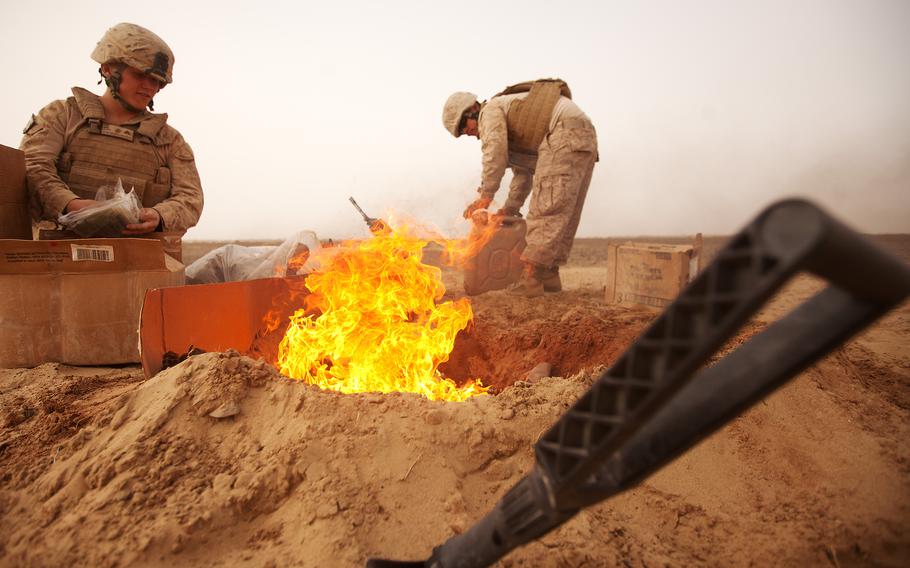
Marine Lance Cpl. Nathanial Fink (left) and Lance Cpl. Garrett Camacho dispose of trash in a burn pit in 2012 in Afghanistan. (Alfred Lopez/U.S. Marine Corps)
WASHINGTON — An influx of claims for illnesses related to toxic exposures is contributing to a surge in requests by veterans for disability benefits and medical compensation, said Willie Clark, deputy undersecretary for field operations at the Veterans Benefits Administration.
Claims made under the Sergeant First Class Heath Robinson Honoring our Promise to Address Comprehensive Toxics Act, or PACT Act, now account for nearly 40% of all claims filed by veterans for service-related disabilities since the legislation was enacted in August 2022.
“The PACT Act has spurred an unprecedented rise in the number of claims processed,” Clark said at a news conference Wednesday, adding approval rates of claims for benefits and services top 75%.
The law extends benefits and health services to qualifying veterans from the Vietnam War, Gulf War and post-9/11 conflicts, and coverage spans 23 medical conditions presumed to be caused from exposure to toxic and hazardous substances.
Bradford Blodgett, a Vietnam veteran, learned about PACT Act benefits at his local Veterans of Foreign Wars post in Connecticut, where a veterans service officer helped him fill out forms related to Agent Orange exposure.
Blodgett, 82, has multiple myeloma, a blood cancer that attacks bone marrow and is associated with Agent Orange exposure. The cancer has perforated his ribs and hollowed several vertebrae, requiring surgery, radiation and chemotherapy.
Blodgett received notice in November 2022 that he was approved for 100% disability related to multiple myeloma. The first check arrived a month later — just in time for Blodgett to cover the property taxes on his Connecticut home.
“My parents were at risk of losing their home due to their inability to pay the taxes,” said Grace Blodgett, his daughter. “The benefit has made a huge difference in their lives. They can afford their groceries and heating, pay their taxes and cover other bills.”
Veterans submitted 1.2 million claims related to the PACT Act from August 2022 through Nov. 18, according to VA figures. Non-PACT claims numbered 1.8 million during the same time.
The Veterans Benefits Administration processed more than 10,200 claims in a single day in mid-November — setting a record for the agency. The number represented all claims filed.
The agency has undertaken a push to hire up to 2,000 more processors to handle the larger volume of claims. Additional staff has enabled the VA to cut by nearly half a backlog of more than 600,000 claims from a year ago.
“Veterans are getting the message that we want them to file PACT Act claims and that doing so will not reduce their current disability rating or their existing benefits,” Clark said.
Qualifying veterans are eligible for benefits to cover medical conditions that are presumed to be caused from exposure to hazardous and toxic materials during military service, including from radiation and burn pits.
Sen. Tom Carper, D-Del., said his office has been working to make certain that veterans know about VA screenings for exposure and how to reach out for help to apply for benefits.
“The PACT Act expands access to VA health care for upwards of 3.5 million post-9/11 veterans, many of whom were exposed to toxic burn pits in Iraq, Afghanistan and other conflict zones around the world,” said Carper, a Navy veteran of the Vietnam War.
Marcellus Beasley, who was exposed to fumes from burn pits during his military service, applied for PACT Act benefits at his local Department of Veterans Affairs office in Wilmington, Del.
Beasley, who served in the Air Force during the Persian Gulf War, said he spent 90 days in Iraq, where he was exposed to burn pits the size of football fields. Trash, sewage, tires and other hazardous materials were incinerated with jet fuel.
“I developed large scales on my skin. If you can imagine how a lizard sheds its skin, that is what was happening to me,” said Beasley, 60. “No one was thinking about covering their face because of the smoke, and the burn pits were everywhere.”
After Beasley left the service, he was diagnosed with psoriasis, a chronic skin condition presumed to be caused from his exposure to burn pits that spewed toxic fumes into the air.
He said he applied for PACT Act benefits with the VA’s help in October 2022 and was approved by January 2023.
“I made an appointment at the VA and met with someone who was almost like a coach and mentor. He helped me provide the in-depth information needed on the form about what happened,” Beasley said.
He now has a full disability rating for medical conditions related to post-traumatic stress disorder, high blood pressure, back and shoulder injuries — and the psoriasis, which requires daily medication and twice monthly injections.
“When we submitted the claim for the PACT benefit and that got approved, it pushed my disability rating to 100%,” Beasley said. “I think I would have been denied if I tried to do this on my own. Servicemen and women are used to being tough and handling things on their own. In this case, the service was free, and I got the help I needed.”